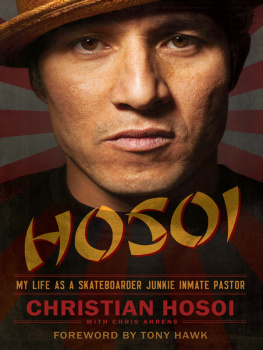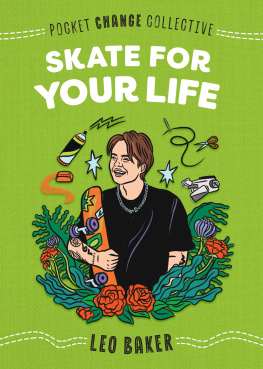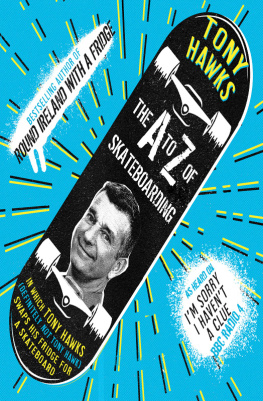C HRISTIAN H OSOI HAS ALWAYS HAD STYLE . T HE FIRST TIME I EVER SAW HIM WAS IN A MAGAZINE, BLASTING A FRONTSIDE OLLIE TO DISASTER IN A SMALL BOWL . H E LOOKED ABOUT MY AGE (TEN AT THE TIME), BUT HAD LONG HAIR AND COLORFUL PADS . M OST IMPORTANT, HIS BODY FORM WAS THAT OF A VETERAN PRO SKATER LAUNCHED INTO THE AIR . I WAS IMMEDIATELY INSPIRED TO LEARN THAT TRICK, WHICH I EMULATED IN THE O ASIS SNAKE RUN ON MY GIANT S IMS A NDRECHT BOARD . I KNEW I WOULD NEVER LOOK THAT STYLISH, BUT I HAD TO TRY . E MULATING C HRISTIAN TO NO AVAIL BECAME A CONSISTENT THREAD IN MY SKATING OVER THE NEXT DECADE .
C HRISTIAN AND I BECAME FRIENDS NOT LONG AFTER, AND EACH OTHERS TOUGHEST COMPETITORS FOR YEARS TO COME . B UT THE BIGGEST CHALLENGE OF BEING COMPARED TO HIM WAS THAT HE COULD MAKE THE MOST BASIC TRICK LOOK GOOD . S O WHEN HE LEARNED SOMETHING NEW, HE DID IT LIKE NOBODY ELSE . H E DID IT IN A WAY YOU WISHED YOU COULD, BUT KNEW YOU WOULD NEVER ACHIEVE . A PRIME EXAMPLE IS WHEN WE BOTH LEARNED 540 S : MINE WERE MECHANICAL, SPINNING FLATLY AND PRECISE . H IS WERE FULLY FLIPPED, AT LEAST SIX FEET HIGH, AND SEEMED TO BE SUSPENDED IN A SLOW-MOTION MIDAIR DANCE . I N ORDER TO COMPETE WITH SUCH STYLE, THE ONLY DEFENSE WAS TO LEARN MORE TRICKS THAN ANYONE . A ND THAT WASNT ALWAYS ENOUGH .
E VENTUALLY, SKATE FANS IN THE 80 S DIVIDED THEMSELVES INTO TWO GROUPS: STYLE VERSUS TECH . Y OU CAN GUESS WHICH SIDE OF THE FENCE I LANDED ON . B UT I ALWAYS TOOK CUES FROM C HRISTIAN TO FIGURE OUT HOW TO GIVE MY LATEST TRICKS A LITTLE MORE FLAIR . T HE ONLY DRAWBACK TO THAT APPROACH IS THAT IF HE LEARNED THE TRICK, IT WOULD BECOME HIS BECAUSE HE DID IT IN A WAY THAT WAS MUCH MORE FUN TO WATCH . I T WAS AN AMAZING TIME OF INNOVATION AND EXPERIMENTING FOR BOTH OF US; WE WERE YOUNG AND SEEMINGLY INVINCIBLE .
A S SKATINGS POPULARITY WANED, HE AND I BOTH HAD STRUGGLES . W E DESPERATELY WANTED TO CONTINUE OUR CAREERS AS PRO SKATERS, BUT THE INDUSTRY WAS CHANGINGMEANING THAT THE PREFERRED STYLE OF SKATING WAS MORPHING INTO STREET-INSPIRED MOVES . E VEN THOUGH WE BOTH HAD A HARD TIME ADAPTING , C HRISTIAN MANAGED TO KEEP UP AND PULL SOME OF THE HARDEST STUFF WITH HIS EVER-STYLISH WAYS . B UT IN THE EARLY 90 S, IT BECAME VERY DIFFICULT FOR EITHER OF US TO MAKE A LIVING SOLELY FROM OUR SKATING SKILLS .
I LOST TOUCH WITH C HRISTIAN IN THE FOLLOWING YEARS BUT HEARD SECONDHAND STORIES OF HIS TOUGH TIMES INCLUDING HEAVY DRUG USE . I DIDNT WANT TO BELIEVE THE RUMORS, BUT MY FEARS WERE REALIZED WHEN I HEARD THAT HE HAD BEEN ARRESTED AND PUT IN JAIL . A S HIS TRIAL AND SENTENCING NEARED , I WROTE LETTERS OF SUPPORT TO THE DISTRICT ATTORNEY, HOPING THAT C HRISTIANS TALE COULD BE ONE OF CAUTION FOR YOUTH TODAY, AND THAT HE COULD TELL HIS STORY PERSONALLY IF HE WERE RELEASED . I HAD FAITH THAT HE WOULD COME OUT ON THE OTHER SIDE WITH STYLE, AND RETURN TO THE SPORT THAT CAME TO DEFINE BOTH OF US . H E HAS SINCE DONE THAT AND MORE, AND WE (AS SKATERS AND PEERS) ARE LUCKY TO HAVE HIM BACK . T HIS BOOK IS PART OF THAT PROCESS . E NJOY THE STORIES OF SUCCESS, EXCESS, AND DEBAUCHERY . B UT LEARN FROM IT, AND REALIZE IT IS TOO EASY TO TAKE YOUR OPPORTUNITIES FOR GRANTED AND LOSE YOURSELF IN THE PROCESS .
C HRISTIANS REDEMPTION IS INSPIRATIONAL, AND HIS SKATING CONTINUES TO EXUDE THE BEST STYLE ; I M STILL JEALOUS OF HIS FRONTSIDE OLLIE DISASTERS BUT I LL KEEP WORKING ON THEM .
TONY HAWK
They called him Christ, and his legions of disciples would follow him anywhere. Now, years past his competitive prime, the name Hosoi continues to inspire many dedicated followers. He was one of the top athletes in the world through most of the 1980s, but few beyond his chosen sport knew much about him in that era. Thats because skateboarding was only decades old at the time and riding well beyond the margins of polite society. Its also because he disappeared right at the peak of his power. Rumors flew suggesting everything from his having lost his mind to his simply having lost interest in the sport hed helped create. Nobody who knew him well would have been surprised if hed turned up dead as a result of a drug deal gone south or his heart giving out from pushing too hard for too long. What is surprising is that he landed in one piece and lived to tell the tale. And what a tale it is.
At this writing there are more kids learning skateboarding than there are entering Little League baseball. In the early 60s, however, skateboardingor sidewalk surfing, as it was often calledwas an undisciplined activity practiced almost exclusively by teenage surfers in their off-hours. About that same time, the boy who would one day become a man, and eventually Christians father, Hawaii-born Ivan Hosoi was surfing the biggest waves he could find on Oahu.
I van soon imported his island style to the U.S. mainland, where he joined kids in risking their necks on homemade skateboards after nailing metal roller skates onto two-by-fours. Next came molded plastic foot-long skateboards with clay wheels. While clay led to newer, better tricks, hitting even the smallest pebble could warrant a trip to the emergency room.
It took urethane to rocket skateboarding into the future: the soft stickiness of the new wheels allowed riders access to steep walls, empty swimming pools, vertical movement, and flight. The wheels also, inadvertently, moved youth culture forward as kids around the world imitated the lives of punk-rock saints Jay Adams and Tony Alva, who had fallen under the influence while blasting to new heights and redefining what it meant to be young and wild in America.
In 1967, Ivan and his wife, Bonnie, had a son they named Christian Rosha Hosoi. The family soon moved to Berkeley, California, where Ivan attended graduate school in art. By the mid-70s the Hosois had relocated to Los Angeles, where punk rock had proven a backlash against the generally passive hippies and had composted perfectly into skateboarding.

EARLY 1967. MOTHER, BONNIE, WHILE FATHER, IVAN, HOLDS FRAME. MY FIRST OF MANY PORTRAITS. HOSOI FAMILY COLLECTION .
While a synthesis of the L.A./Berkeley art scene, surfer cool, street smarts, and the psychedelic revolution, Christian was also his own persona blend of ideas born in his own brain from a massive collage of experiences. The result was to turn the act of riding a skateboard into high-level performance art. Eventually the act would be performed far above thousands of gasping fans who realized that levitating at such altitudes could prove lethal. Everywhere he went, from Hollywood to London, he was celebrated as the best vertical and aerial skateboarder in the world.
That unofficial and underground title wouldnt mean much to anyone but the few thousand hard-core skaters who lived and died by his every move, if Hosoi hadnt also been a factor in a bigger world. He was, as anyone on hand will tell you, the sports first and most enduring rock star and its most charismatic entertainer to date. It is well established by skate historians (yes, there is such a thing) that 80s skating belonged to Hosoi and his only real rival, Tony Hawk. Hawk readily admits, When Christian was on fire, he was unbeatable. With a seemingly endless variety of his own rapid-fire tricks, Hawk emerged victorious more than anyone, including Hosoi. Yet it was the newly anointed high-flying Christ, bad-boy flag waving in the face of conformist patriotism, who often won the crowd. Where Tony was technical innovation, Christian was aerodynamic soul, sometimes trumping Hawks amazing new finger-flipping tricks with dramatic moves of his own, like his signature Christ Air. His electrified performances caused him to stand out like Jimi Hendrix at a folk music festival.











